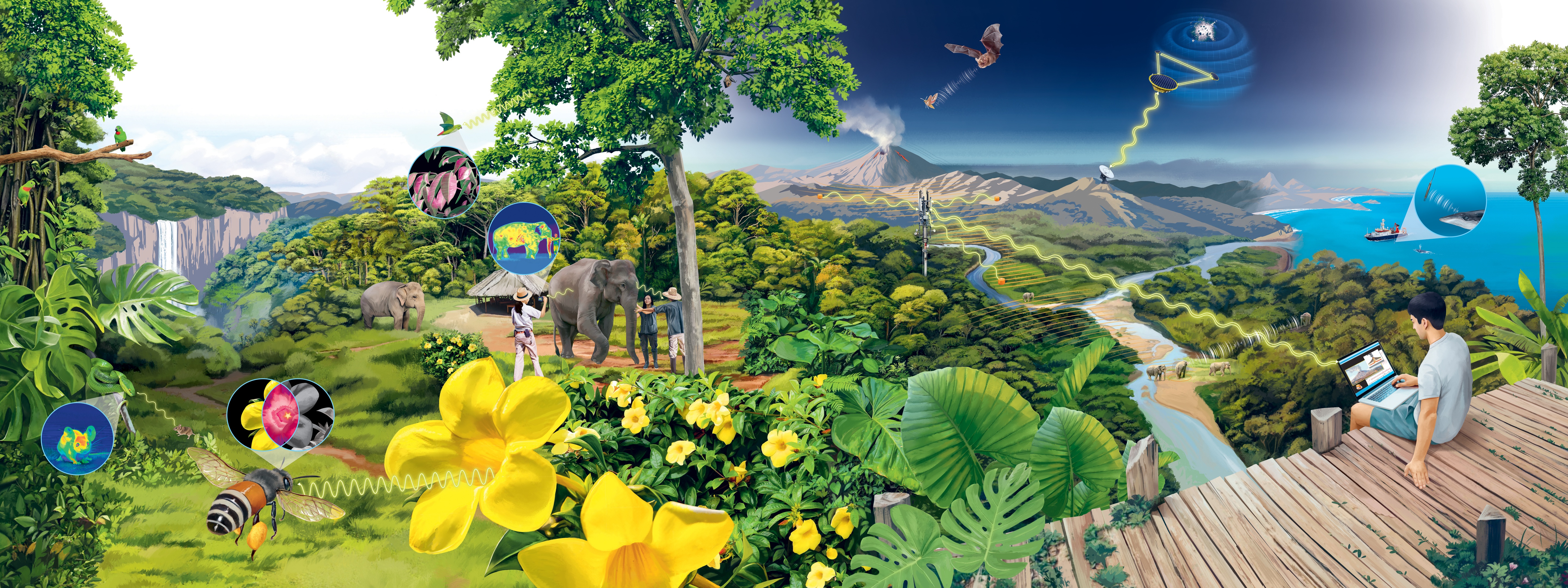I Spy with My Little Eye
Using waves as a key to the world thanks to matching receivers
Our world is full of colours that we see with our eyes and sounds that we hear with our ears. For many animals,
the world appears very different because they can perceive things that are hidden from our senses. In order to
expand our perception and unlock new worlds, we develop suitable receivers.

Devices On
In order to perceive more than what is naturally possible for us, we develop receivers such as satellites and seismometers as well as special cameras and microphones. With these, we measure tremors at active volcanoes, record infrasound of communicating whales or see the heat of inflamed joints in an elephant. This enables us to discover hidden worlds and thus develop a deeper understanding of natural processes as well as the animal and plant world.
A new kind of perception was attained in 2015 when gravitational waves were recorded for the first time. Gravitational waves stretch and compress space and temporarily change the shape of the objects they encounter and the distance between them. The LISA (Laser Interferometer Space Antenna) mission led by ESA is a giant gravitational wave detector planned for 2034: three satellites connected to each other by laser beams over a distance of 2.5 million kilometres will measure even the smallest deformations in space. We hope that this will provide us with new insights into the formation of the universe, including the Big Bang.
Ears Open
We can only hear sound waves in a certain range of wavelengths. If particularly low sounds are loud enough, we can also feel them as vibrations. There are more sound waves below and above our hearing range: infrasound and ultrasound.
Some animals communicate with infrasound, which travels long distances due to its long wavelength. Infrasound produced by elephants can reach the volume of a thunderstorm; that produced by whales can be as loud as a space shuttle taking off.
Elephants ‘hum’ to produce low-frequency sounds which can be heard by fellow elephants several kilometres away. The humming also causes their whole body to vibrate, and this vibration is transmitted through the ground like the waves from an earthquake. Other elephants can feel these seismic waves through their trunks and the soles of their feet at a distance of more than 10 kilometres.
Whales communicate with infrasound even across entire oceans. In addition, they emit clicking sounds in the shortwave ultrasound range, which they use for navigation and to catch prey – just like dolphins and bats. Some moths have developed an ear for ultrasound in order to escape from bats and can emit ultrasound themselves in order to confuse their predators.
Eyes Open!
The light visible to us is made of electromagnetic waves in a certain range of wavelengths. We cannot see waves outside this range, such as shortwave UV or longwave infrared radiation. Some animals, however, can.
Honey bees see not only in the visible range, but also in the UV range. They are guided directly to nectar by structures in flowers that are only visible in the UV range.
Parrots and other bird species perceive the contrast between the top and bottom of leaves more clearly thanks to UV vision. This probably enables them to navigate in dense forests. UV vision also plays a role in finding a mate: male birds’ feathers appear brighter when they have a strong immune system.
Some cold-blooded animals have the ability to ‘see’ heat in the form of infrared radiation: certain species of snakes have a special organ that enables them to detect warmblooded prey even in the dark or when visibility is poor.